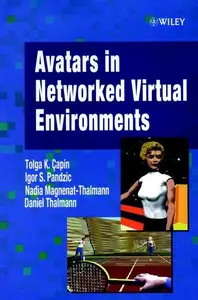- Témaindító
- #1
- Csatlakozás
- 2024.09.10.
- Üzenetek
- 20,532
- Reakció pontszám
- 2
- Díjak
- 5
- Kor
- 37

Free Download Avatars in Networked Virtual Environments By Tolga K. Capin, Igor S. Pandzic, Nadia Magnenat?Thalmann, Daniel Thalmann(auth.)
1999 | 273 Pages | ISBN: 0471988634 | PDF | 4 MB
Avatars in Networked Virtual Environments Tolga K. Capin Computer Graphics Lab, EPFL, Lausanne, Switzerland Igor S. Pandzic MIRALab, University of Geneva, Switzerland Nadia Magnenat-Thalmann MIRALab, University of Geneva, Switzerland Daniel Thalmann Computer Graphics Lab, EPFL, Lausanne, Switzerland Telepresence is the future of multimedia systems and will allow participants to share professional and private experiences, meetings, games and parties. Networked Virtual Environments (NVEs) are systems that allow distant users to interact in a common Virtual Environment. One of the areas of research in NVEs is the user representation or 'avatar', the way that participants are geographically represented in Virtual Environments. * Examines solutions to the Virtual Life Network (VLNET) system, a flexible framework for Virtual Humans in NVEs * Presents different means of facial communication, gesture and non-verbal communication * Provides details for solving all problems of handling Virtual Human data across the network * Analyses the potential relation of the future MPEG-4 standard to NVEs * Discusses the standardisation of Virtual Humans in VRML * Includes applications such as a Virtual tennis game and studies the experimental results and achievements. Essential reading for a wide-ranging audience including computer scientists, engineers in communication systems, undergraduate and postgraduate students of computer science, and researchers in computer animation, visualisation and communications technology. Content: Chapter 1 Concepts in Networked Virtual Environments (pages 1-14): Chapter 2 A Taxonomy of Networked Virtual Environments (pages 15-57): Chapter 3 The VLNET System (pages 59-97): Chapter 4 Representation of Virtual Humans (pages 99-139): Chapter 5 Facial and Gestural Communication (pages 141-168): Chapter 6 Networking Data for Virtual Humans (pages 169-199): Chapter 7 Standards for NVEs and Virtual Humans (pages 201-216): Chapter 8 Applications and Experiments (pages 217-249): Chapter 9 Conclusion (page 251):
Buy Premium From My Links To Get Resumable Support,Max Speed & Support Me
Code:
⚠
A kód megtekintéséhez jelentkezz be.
Please log in to view the code.
